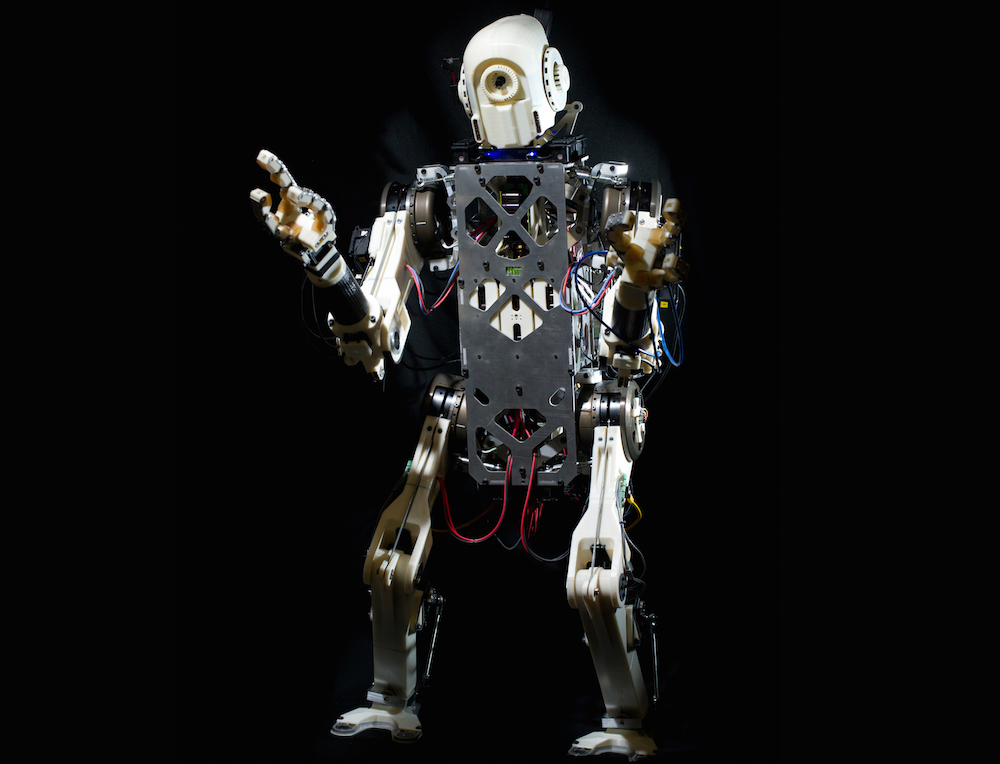Futuristic Exoskeleton Keeps Clumsy Robot from Falling Over

Like an angry ninja, a robot karate-chops a wooden plank, punches through drywall, smashes soda cans and kicks over a trash bin blocking its path in a new video from the Massachusetts Institute of Technology (MIT).
The two-legged machine isn't really a troublemaker. In fact, it's not actually in control of its own actions. A researcher standing a few feet away from the bot keeps the machine's every move in check with the help of an exoskeleton — a sort of mechanical belt with armrests that the researcher wears around his waist and upper body.
Engineers at MIT developed the bipedal bot, which they call Hermes, with funding from the Defense Advanced Research Projects Agency (DARPA). And now, the researchers are developing the human-machine interface to make this technology more useful outside of the lab. [The 6 Strangest Robots Ever Created]
Also known as a balance-feedback interface, the researchers' exoskeleton translates the natural reflexes of the human body into a language that a machine can understand. Bestowing the robot with humanlike reflexes — for example, having it steady itself by rocking back on its heels after a punch — helps the bot stay upright instead of falling over.
Bipedal robots like Hermes are notoriously clumsy. A lengthy blooper reel from this year's DARPA Robotics Challenge (DRC), in which a slew of two-legged bots struggled to complete a variety of tasks without tumbling over, is proof enough of that.
But the balance-feedback interface developed at MIT could give bipedal bots the sturdiness they need to stay upright and, eventually, complete difficult tasks in the real world. The hope is that these so-called "humanoid" robots will one day be able to do work that's dangerous for humans — things like sifting through debris after an earthquake or putting out a fire, according to Joao Ramos, a doctorate student of mechanical engineering who is working on MIT's new human-machine interface. (He's also the one seen controlling Hermes in the video.)
“The processing of images is typically very slow [for a robot], so a robot has difficulty reacting in time,” Ramos said in a statement. “Instead, we’d like to use the human’s natural reflexes and coordination. An example is walking, which is just a process of falling and catching yourself. That’s something that feels effortless to us, but it’s challenging to program into a robot to do it both dynamically and efficiently."
Get the world’s most fascinating discoveries delivered straight to your inbox.
The tipping point
Walking, punching, kicking, swinging things through the air: These are all good examples of tasks that require both forward momentum and balance.
To help the robot master these kinds of movements, the researchers first had to figure out the 100-pound (45 kilograms) bot's tipping point, so to speak. To do this, they put load sensors on both of the robot's feet. These sensors measured the force exerted by each foot on the ground and were used to calculate the bot's center of pressure, or how it shifted its weight, as it performed different tasks.
Then, the researchers built the "human" portion of the human-machine interface. The researchers constructed a motorized platform on which the person controlling the bot stands. The human in control also wears the futuristic-looking exoskeleton, which fits around the waist. The exoskeleton is connected to the motorized platform, which in turn is connected to a computer.
The computer receives information about the robot's changing center of pressure and sends this information to the platform's motor. Finally, the motor applies force to the exoskeleton based on the bot's movements. In other words, whoever is wearing the exoskeleton gets knocked around as the bot moves its body.
“If the robot is leaning too far forward, the interface will push the operator in the opposite direction, to convey that the robot is in danger of falling," Albert Wang, a doctoral student working on the new interface, said in a statement.
So far, the interface has kept the bot from tumbling over as it punches through drywall and received repeated hits on its torso from a hammer. Next, the researchers would like to move on to more challenging tasks, such as having the bot swing an ax and open a spring-loaded door. These are the sorts of tasks that are particularly tough for bots to complete without falling over, according to Wang. But it might be easier for bots to do these jobs now that they have help from reflex-ready humans.
Follow Elizabeth Palermo @techEpalermo. Follow Live Science @livescience, Facebook & Google+. Original article on Live Science.

